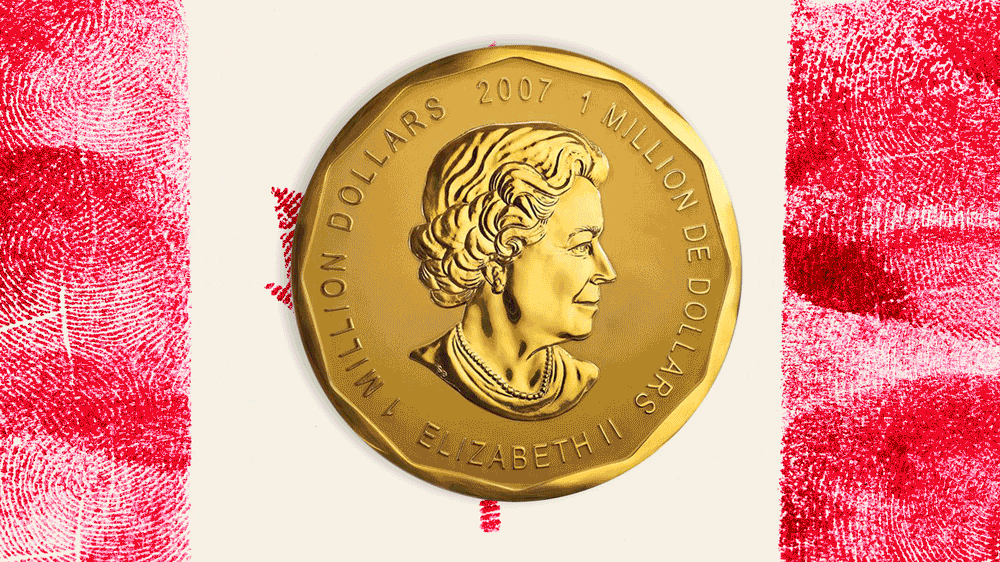And you thought carrying loose change in your pocket was a nuisance... Imagine hauling a 220-pound giant gold coin out a window, down a ladder, across the train tracks and into a getaway car.
It may seem like an outlandish proposition, but that’s exactly what a group of thieves decided to do in March when they set their sights on the “Big Maple Leaf,” a 99.999 percent pure gold coin over an inch thick and 20 inches in diameter that was on display at the Bode Museum in Berlin.
They succeeded. While four men were eventually arrested, the coin was never found, presumed to have slipped out of the fingers of the authorities after it was melted down and the gold sold off.
The story behind this big ball of bling begins back in 2007, when the Royal Canadian Mint was gearing up to release their latest series of bouillon coins.
The mint had achieved a milestone in the industry. They had developed the technique to create coins that were 99.999 percent pure, or “five-nines” in mint-speak. The last time the Canadians had reached such a milestone was in 1982, when they produced gold that was 99.99 percent pure.
The minting of bullion around the world is a competitive game, with each organization striving to be the very best when it comes to producing gold. Each mint releases the product of their labors in the form of bullion coins stamped with their own personalized theme—the Philharmonic for Austria, the American Eagle in the U.S., and the Australian Kangaroo for Perth.
The Royal Canadian Mint was excited to release their latest 1 ounce Gold Maple Leaf coins and blow their competitors out of the water in terms of purity.
But in order to debut such a glittering achievement, they needed a form of advertisement that would have an equal wow factor—they needed a show-stopper.
What better way to announce a gold coin of the highest purity in the world than by blowing it up into a massive, 3,215-ounce solid gold wonder. Or, as the Royal Canadian Mint put it, they created the Big Maple Leaf, “Because we can.”
The result showed off the mint’s feats of engineering. After the designs for each side—a portrait of Queen Elizabeth II drawn by Canadian artist Susanna Blunt on the front and a giant maple leaf on the reverse—were computerized and turned into a cast mold, molten gold that had reached over 2000-degrees Fahrenheit was poured into it at a steady rate to make a giant gold coin with the least imperfections possible.
The final product was hand polished over and over again and the designs touched up by craftsmen to create the shiny result they referred to as the million-dollar coin after its face value.
“We created this coin as a one-off,” Alexandre Reeves, senior adviser of external communications at the Royal Canadian Mint, tells The Daily Beast. “It was meant to promote the line of one-ounce, five-nines pure gold bullion coins. But when we unveiled the million dollar coin, interested buyers came forward and they said, ‘Well I’d like to have one of these coins for myself.’”
In the end, the Royal Canadian Mint created six of these whoppers, the original of which they kept while the other five were sold to buyers (mostly anonymous) around the world.
The Big Maple Leaf, as it came to be known, received one additional distinction: In 2007, it was named the largest coin in the world by the Guinness World Records. (The Perth Mint has since taken the size title, although Canada still reigns when it comes to purity.)
After WWI, money in all of its forms became so pervasive that there are next to zero opportunities for newer vintages, so to speak, to become rare and valuable collectables. Bullion entered this landscape and, while often showing off expert metal craftsmanship, became primarily acquired as an investment, a fancier alternative to a bar of gold.
As Cristiano Bierrenbach, executive vice president of International Numismatics at Heritage Auction House puts it, “[The Big Maple Leaf] has no particular significance, numismatic significance, or collector’s significance. For us, it’s just a big chunk of gold.”
Despite being valuable mostly for its material—and it was quite valuable, clocking in at around $4 million in market worth—one of the five sold took up residence in the Bode Museum in Berlin in December 2010 on loan.
The Bode Museum is known for its numismatic collection, which contains over half a million pieces that are displayed in a rotating selection in four cabinets on the second floor of the building.
While the Big Maple Leaf may not have been nearly as precious as an ancient Greek coin, it was still a big draw at the museum, particularly among the younger crowd.
A group of thieves from Berlin also set their sights on the museum.
They concocted a plan to get their hands on the gold in what was widely described as an “old-fashioned heist.”
In the early hours of the morning on March 27, during the two-and-a-half hour window in which the S-Bahn train went to bed each night, the men climbed the elevated train tracks behind the museum.
They placed a ladder on the tracks reaching up to the third floor window of the museum, climbed into the building, and made their way to the numismatic department.
There, they smashed through the bullet-proof glass protecting the Big Maple Leaf with what was most likely a sledge hammer (take that, guns), and grabbed their hefty prize.
They then reversed their route, lugging the 220-pound coin along the way. “Once outside the museum, the thieves used a wheelbarrow to push their loot 100 meters down the tracks and across a bridge over the river to nearby Monbijou Park, where they dropped and most likely damaged the coin while abseiling to the ground,” The Guardian reported.
The Big Maple Leaf had been specifically targeted—nothing else in that case or in the rest of the collection was touched and the entire heist was pulled off without tripping a single security alarm.
Nearly four months later, investigators arrested four suspects in the case, but the coin was never found, to no surprise of the authorities, who by believed that it had already been melted down.
“The trick used by such criminals is that they add, for example, a little bit of copper to the molten gold in order to change the purity levels and cover their tracks,” one investigator told Die Welt.
The theft was a huge loss for the unidentified owner—The New York Times reported that it was worth around $4.5 million on the market at the time of its disappearance. But, while the value of the loss was significant, it was mostly a financial shame rather than an artistic one.
“It would have been much different if… they had stolen a year one shekel of the Jewish War and they melted that for $8 of silver and that coin is a million dollar coin. That would have been a tragedy,” Bierrenbach says. “This coin, from the collector perspective, from the numismatic perspective, and the historical perspective, it’s meaningless. It’s the same as [if] somebody just stole a bunch of gold bars.”
The Royal Canadian Mint doesn’t entirely disagree. While Reeves says this theft was a shame, “at the end of the day it wasn’t our coin.”
“Although one coin seems to have been lost, we’re happy that we have other customers enjoying their own masterpieces and we’re very proud to have our own masterpiece to showcase,” Reeves says. “And that coin is safe and secure… and will remain so.”





